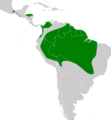Red-throated caracara facts for kids
Quick facts for kids Red-throated caracara |
|
|---|---|
 |
|
| Conservation status | |
| Scientific classification | |
| Genus: |
Ibycter
|
| Species: |
americanus
|
 |
|
| Synonyms | |
|
|
The red-throated caracara (Ibycter americanus) is a special type of bird of prey that lives in groups. It belongs to the Falconidae family, which includes falcons and other caracaras. This bird is unique because it mostly eats the young (larvae) of bees and wasps. It also enjoys eating adult insects, fruits, and berries.
You can find the red-throated caracara in Central and South America, from Mexico all the way down to Venezuela. It prefers to live in warm, wet forests, especially those in lowlands or on mountains.
Contents
About the Red-throated Caracara's Name
The red-throated caracara got its scientific name, Falco americanus, in 1783 from a Dutch scientist named Pieter Boddaert. For many years, this bird was grouped with the black caracara in a different scientific group called Daptrius.
However, after scientists studied the birds' genes in 1999, they decided the red-throated caracara was special enough to have its own group. So, it was moved to a group called Ibycter. This name was first suggested by a French bird expert, Louis Pierre Vieillot, back in 1816. The name Ibycter comes from an old Greek word that means "singer of war-songs."
What Does the Red-throated Caracara Look Like?
Red-throated caracaras are medium-sized birds. Males are usually about 51 cm (20.1 inches) long, while females are a bit bigger, around 56 cm (22.1 inches). Most of their feathers are black. However, their belly, tail feathers, and the feathers under their tail are white.
A very noticeable feature is their face and throat, which are bare (without feathers) and bright red. You might see a few black feathers scattered on their red throat. Both male and female red-throated caracaras look very similar.
Where Do Red-throated Caracaras Live?
These birds live in the humid, wet forests of many countries. You can find them in Brazil, Bolivia, Colombia, Costa Rica, El Salvador, Ecuador, French Guiana, Guatemala, Guyana, Honduras, Mexico, Nicaragua, Panama, Peru, and Venezuela.
The red-throated caracara flies slowly, which helps it move through the lower parts of the forest where the trees are not too thick. This open space allows the caracara to see its food and also spot any dangers. Some of its predators, like the ornate hawk-eagle and the black-and-white hawk-eagle, are also birds of prey.
How Red-throated Caracaras Hunt and Eat
Red-throated caracaras are very clever hunters. They usually look for insect nests in the tops of trees (the canopy) and in the lower parts of the jungle. Most of the time, they hunt quietly. Sometimes, they make soft calls or hunt together in groups.
When they hunt in groups, one or two birds will watch for predators from the treetops. The rest of the group hunts below. Red-throated caracaras are very protective of their home area, and a group usually has four to eight birds.
What Do They Eat?
Their main food is the larvae (young) of wasps and bees. But they also eat adult insects, and they enjoy fruits and berries found in their forest homes. The health of the forest is super important for these birds because wasps and bees often build their nests in old, big trees.
Sadly, cutting down forests and using too much land for farming makes it hard for these birds to find food. This is why red-throated caracaras are not seen as often today. After the 1950s, their numbers dropped quickly in places like Costa Rica and Panama. Because of this, they were placed on the World Wildlife endangered list for a while.
Hunting Wasps and Bees
For a long time, scientists didn't know much about how these birds hunted. But in 2013, a team of Canadian scientists watched them closely in French Guiana. They used cameras to record the birds.
The videos showed that the caracaras use a quick "fly-by" attack. They dive down fast to knock wasp nests onto the forest floor. They are very skilled and usually avoid getting stung! The birds work together, diving and scooping up repeatedly to confuse the angry wasps defending their nest. Researchers found that the wasps eventually give up on their damaged nests and move to build a new one somewhere else.
Scientists are still learning how this special hunting method affects the number of wasps. They also don't know if the birds are naturally protected from stings. They found some chemicals on the birds' feet that are similar to those from Azteca ants, which might be picked up from trees where both species live.
Images for kids
See also




